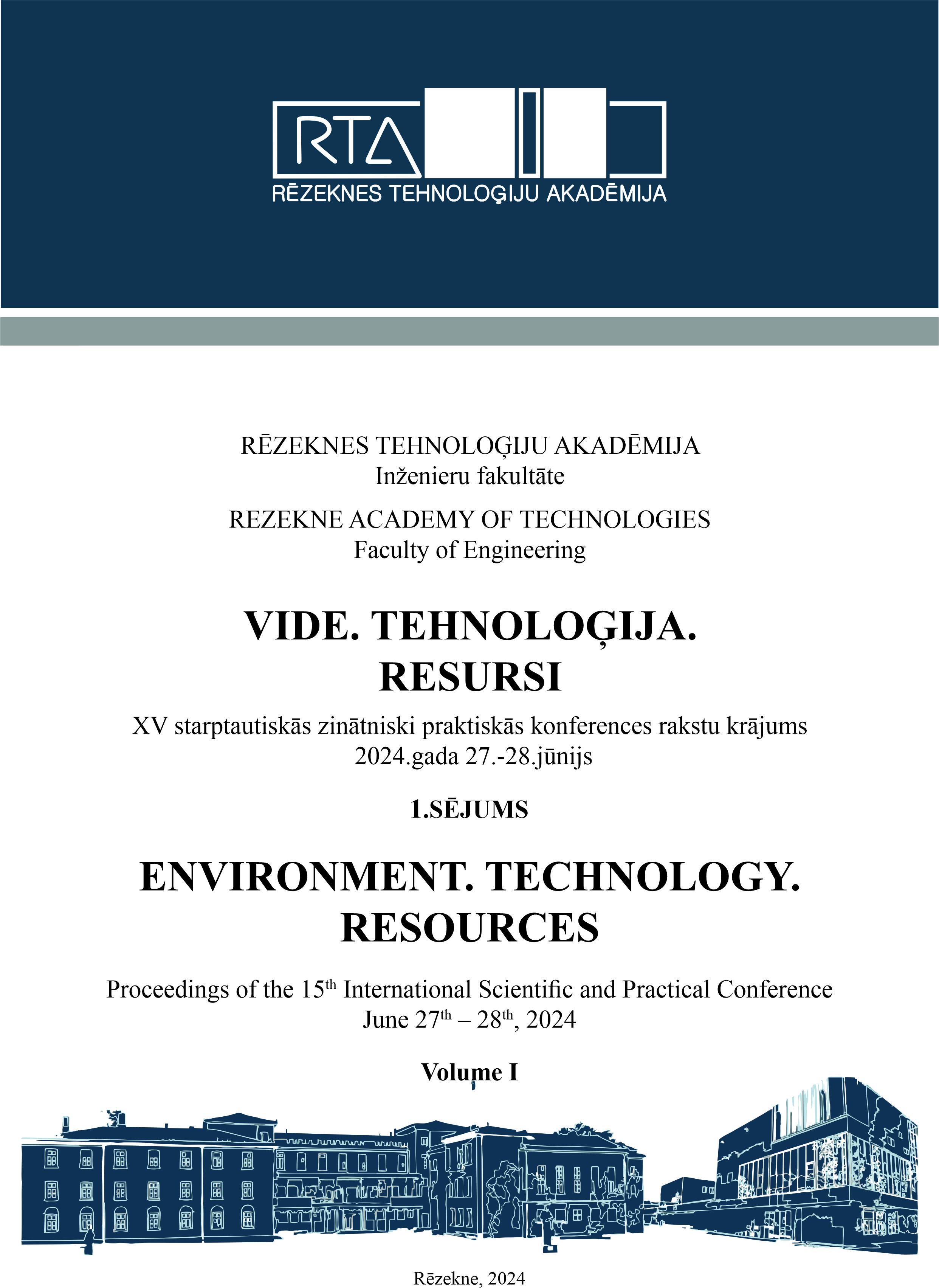SOIL AMENDMENTS BASED ON FOREST LOGGING RESIDUES ON DILL (ANETHUM GRAVEOLENS L.) PRODUCTIVITY AND COMPOSITION
DOI:
https://doi.org/10.17770/etr2024vol1.7983Keywords:
Forest logging residues, growth activation, organo-mineral soil amendments, siliconAbstract
The purpose of this work was to evaluate the impact of low rates of application of environmentally friendly organo-mineral soil amendments on grown under organic farming conditions dill’s green mass yield and it’s composition, including the content of polyphenolic compounds. Soil amendments were obtained based on forest logging residues – lignocellulosic biomass, after isolation of polyphenols by water-ethanol extraction and enrichment with silicon (Si)-containing inorganic oligomer in various mass ratios. Lignocellulosic biomass is rich in polyphenols which can damage the functionality of the bacterial cell membranes thus inhibiting the growth of soil microorganisms. Polyphenols can be isolated from the lignocellulosic substrate and evaluated in further studies for their potential to protect plants from pathogenic microorganisms. The influence of the prepared soil amendments on soil microorganisms was tested. Field experiments were carried out in a certified biological field intended for scientific purposes. It was shown that soil amendments have a beneficial effect on the yield (42%) and a slight influence on the composition of dill at low amendment application rates. The addition of soil amendments also contributed to insignificant changes in the amount of polyphenols. The soil amendments didn’t influence the soil microorganisms under study. The results confirmed the ability of the soil amendments based on the forest logging residues to activate dill growth.
References
“Eurostat. Statistics explained. Forests, forestry and logging.” Dec. 2023. Accessed: Feb. 25, 2024. [Online]. Available: https://ec.europa.eu/eurostat/statistics-explained/index.php/Forests,_forestry_and_logging“Supporting policy with scientific evidence. Logging residues.” Accessed: Feb. 24, 2024. [Online]. Available: https://knowledge4policy.ec.europa.eu/glossary-item/logging-residues_enT. Moskalik and A. Gendek, “Production of Chips from Logging Residues and Their Quality for Energy: A Review of European Literature,” Forests, vol. 10, no. 3, p. 262, Mar. 2019, doi: 10.3390/f10030262.European Commission. Joint Research Centre., Biomass production, supply, uses and flows in the European Union: first results from an integrated assessment. LU: Publications Office, 2018. Accessed: Feb. 25, 2024. [Online]. Available: https://data.europa.eu/doi/10.2760/539520C. Sánchez, “Lignocellulosic residues: Biodegradation and bioconversion by fungi,” Biotechnology Advances, vol. 27, no. 2, pp. 185–194, Mar. 2009, doi: 10.1016/j.biotechadv.2008.11.001.Tomasz Gałęzia, “Uwarunkowania ekonomiczne utylizacji pozostałości zrębowychEconomic methods for the utilisation of logging residues”, doi: 10.48538/FRP-2016-0006.M. T. Pergola et al., “Towards sustainable management of forest residues in the southern Apennine Mediterranean mountain forests: a scenario-based approach,” Annals of Forest Science, vol. 79, no. 1, p. 14, Dec. 2022, doi: 10.1186/s13595-022-01128-w.R. Pokharel, R. K. Grala, D. L. Grebner, and S. C. Grado, “Factors affecting utilization of woody residues for bioenergy production in the southern United States,” Biomass and Bioenergy, vol. 105, pp. 278–287, Oct. 2017, doi: 10.1016/j.biombioe.2017.07.002.R. L. Howard, E. Abotsi, V. R. E. L. Jansen, and S. Howard, “Lignocellulose biotechnology: issues of bioconversion and enzyme production,” Afr. J. Biotechnol., vol. 2, no. 12, pp. 602–619, Dec. 2003, doi: 10.5897/AJB2003.000-1115.S. Khatami, “Lignin; a Likely Precursor of a Significant Fraction of Humic Substances Via Oxidative Transformations,” Old Dominion University Libraries, 2020. doi: 10.25777/0AZG-8172.A. Andersone, S. Janceva, N. Zaharova, A. Svarta, and G. Telysheva, “LIGNIN AND LIGNOCELLULOSE-BASED ORGANOMINERAL COMPLEX FOR ORGANIC AGRICULTURE,” presented at the 23rd SGEM International Multidisciplinary Scientific GeoConference 2023, Albena, Bulgaria, Oct. 2023, pp. 247–256. doi: 10.5593/sgem2023/3.1/s13.30.M. Greger, T. Landberg, and M. Vaculík, “Silicon Influences Soil Availability and Accumulation of Mineral Nutrients in Various Plant Species,” Plants, vol. 7, no. 2, p. 41, May 2018, doi: 10.3390/plants7020041.“Republic of Latvia, Cabinet Regulation No. 461. Requirements for Food Quality Schemes, Procedures for the Implementation, Operation, Monitoring, and Control Thereof.” Aug. 12, 2014.A. Andersone et al., “Granulated Animal Feed and Fuel Based on Sea Buckthorn Agro-Waste Biomass for Sustainable Berry Production,” Sustainability, vol. 15, no. 14, p. 11152, Jul. 2023, doi: 10.3390/su151411152.S. Janceva, T. Dižbite, G. Teliševa, L. Vēvere, J. Krasiļņikova, and M. Dzenis, “Assessment of Alder Tree Bark Potential as a Renewable Source of Proanthocyanidins in Latvia,” Materials Science and Applied Chemistry, vol. 33, no. 1, Jan. 2016, doi: 10.1515/msac-2016-0005.A. Andersone et al., “Lignocellulosic Waste Compounds for Pancreatic Lipase Inhibition: Preliminary Extraction by Freon, Obtaining of Proanthocyanidins and Testing on Lipase Activity,” Metabolites, vol. 13, no. 8, p. 922, Aug. 2023, doi: 10.3390/metabo13080922.Zakis, G., “Application of high-frequency conductometry in chemical analysis of wood (in Latvian). Secion 14.5.,” in Fundamentals of Wood Chemistry, Institute of Wood Chemistry, 2008, pp. 180–183.“Conductometric titration.,” in Functional Analysis of Lignins and Their Derivatives, TAPPI PRESS, Atlanta, GA,1994, p. 36.H. Debelo, M. Li, and M. G. Ferruzzi, “Processing influences on food polyphenol profiles and biological activity,” Current Opinion in Food Science, vol. 32, pp. 90–102, Apr. 2020, doi: 10.1016/j.cofs.2020.03.001.L. Bouarab Chibane, P. Degraeve, H. Ferhout, J. Bouajila, and N. Oulahal, “Plant antimicrobial polyphenols as potential natural food preservatives,” J Sci Food Agric, vol. 99, no. 4, pp. 1457–1474, Mar. 2019, doi: 10.1002/jsfa.9357.K. B. Pandey and S. I. Rizvi, “Role of red grape polyphenols as antidiabetic agents,” Integrative Medicine Research, vol. 3, no. 3, pp. 119–125, Sep. 2014, doi: 10.1016/j.imr.2014.06.001.
Downloads
Published
Issue
Section
License
Copyright (c) 2024 Sarmite Janceva, Anna Andersone, Natalija Zaharova, Vizma Nikolajeva, Agrita Svarta

This work is licensed under a Creative Commons Attribution 4.0 International License.



